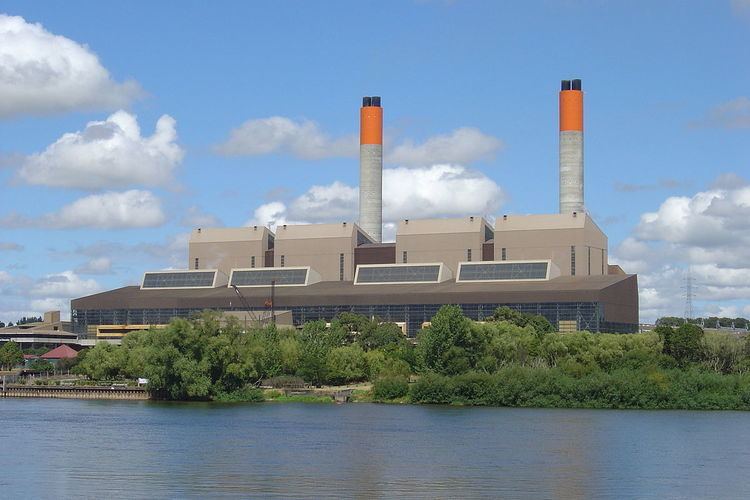Status Operational Phone +64 7-828 6800 | Commission date 1983 (1983) | |
 | ||
Hours Closing soon · 7:30AM–4PMFriday7:30AM–4PMSaturdayClosedSundayClosedMonday7:30AM–4PMTuesday7:30AM–4PMWednesday7:30AM–4PMThursday7:30AM–4PM Similar Z, Mobil, Huntly Station, Hakarimata Scenic Reserve, Solid Energy | ||
Huntly power station huntly new zealand aotearoa
The Huntly Power Station is the largest thermal power station in New Zealand and is located in the town of Huntly in the Waikato. It is operated by Genesis Energy Limited, a publicly listed company (currently 51% owned by the NZ Government), and is capable of supplying over 31% of the country's current electricity needs. The station has four operational generating units – two 250 MW coal-and-gas-fired steam turbine units, a 50 MW gas peaking plant, and a 403 MW combined cycle gas turbine plant.
Contents
- Huntly power station huntly new zealand aotearoa
- Waikato river huntly power station
- Generation
- Fuel and coolant
- Transmission and distribution
- Future
- In popular culture
- References
Waikato river huntly power station
Generation
Each of the four original generating units, which are capable of burning either coal or gas, installed in stages between 1973 and 1985, is capable of generating 250 MW (Megawatts) of electricity, giving a historical generating capacity of 1000 MW. Its chimneys are 150 metres high and each chimney has two flues that are 7 metres in diameter. The plant uses a reheat steam cycle, with C A Parsons turbines and Combustion Engineering boilers.
In 2004 the power station was upgraded with the addition of a 50 MW gas turbine plant, and in 2007 the combined cycle gas turbine (CCGT) plant was commissioned. This plant increased the total generating capacity of Huntly by 403 MW (250 MW gas turbine + 135 MW steam turbine). The new turbine represented an investment of NZ$520 million and it increased the total installed capacity to 1453 MW.
In 2007, Huntly operated at a load factor of 85% and was providing a large amount of the baseload energy needs of the northern North Island. In 2007, the plant was mainly gas-fired, but a dry winter in 2008 prompted more coal thermal generation.
In December 2012, Genesis Energy placed one of the four Huntly Power Station 250 MW units into long-term storage. In 2013, a second coal-fired generating unit was placed into storage, available to return to service, if required, within 90 days. The second 250 MW unit was permanently retired in June 2015.
Fuel and coolant
Up to 50% of the coal used in the older section of the power plant is imported from Indonesia, and the remainder mined in New Zealand. Previous to the substitution of coal, Huntly used gas from the fields to power the generation of the main units as well, but these were switched in the 1990s because of dwindling resources.
Natural gas to power units 5 and 6 comes from several gas fields in Taranaki. The gas is transmitted along the 307 km, 750 mm diameter Maui gas pipeline from Oaonui production station near Opunake, which was commissioned in 1979 to supply the station.
The station uses water from the Waikato River for cooling. However, in order to protect aquatic life, conditions are imposed by the resource consent (issued under the Resource Management Act), specifying the quantity of water that can be removed by the station along with the maximum temperature of the water when returned to the river (25 °C). These conditions mean that on very hot summer days the station cannot operate at maximum capacity, and has sometimes effectively been shut down. A new cooling tower has been built as part of expansion works at the site, which allows one 250 MW unit to run at full load even during such times.
Transmission and distribution
The majority of the energy generated at Huntly Power Station is transmitted through the national grid to Auckland, New Zealand's largest city, which lies 95 kilometres (59 mi) to the north of the station.
Huntly is connected to the rest of the national grid via a large substation switchyard and six 220 kV transmission circuits carried on three high capacity transmission lines. These transmission lines are:
The Huntly switchyard also includes a grid exit point for supply to the local distribution network in the Huntly area.
Future
The plant, as one of the biggest carbon dioxide greenhouse gas generators of the country, contributing over half of New Zealand's emissions of greenhouse gases from electricity generation, has repeatedly drawn the ire of environmentalists and has been the focus of associated protests. A 2006 government report outlining future climate change mitigation and energy policies was seen by the operator as a sign that the plant might have to be closed by 2015 under these plans, with around 10 years of design life still remaining. It was also noted that, apart from being difficult to replace as a source of power (due to New Zealand's annually growing generation demand, especially around Auckland), such a decision would also be uneconomical for the foreseeable future, even if coal prices were to rise.
In May 2012, resource consent was granted by the Waikato Regional Council to continue running the gas and coal units for a period of 25 years. This shows that the Huntly Power Station can continue to have a strategic long term role in New Zealand energy generation.
In April 2016, Genesis Energy announced that the Huntly Power Station would continue operation of its two remaining coal / gas burning units until December 2022. The two gas turbine generators would continue to operate into the future.
In popular culture
In the online game ElectroCity, run by Genesis Energy, coal-fired power stations take the form of Huntly.
